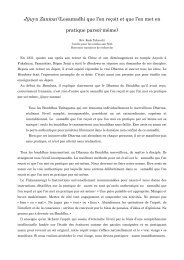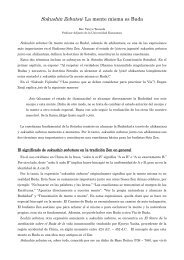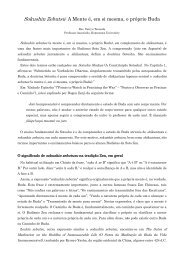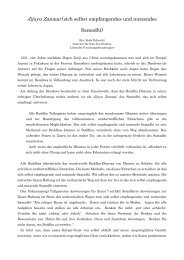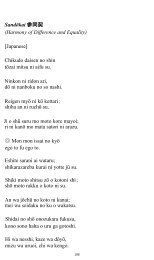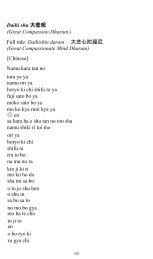Genjo Koan (Complete manifestation of established ... - sotozen-net
Genjo Koan (Complete manifestation of established ... - sotozen-net
Genjo Koan (Complete manifestation of established ... - sotozen-net
Create successful ePaper yourself
Turn your PDF publications into a flip-book with our unique Google optimized e-Paper software.
He uses the sea’s appearance when we sail on it as a metaphor. The world reflected by the senses<br />
is the only thing that the practitioner’s eyes can perceive at that moment.<br />
Then what attitude should the practitioner who studies the reality <strong>of</strong> genjo koan have? In<br />
Shobogenzo <strong>Genjo</strong> <strong>Koan</strong> we read<br />
Fishes swim in the water and however much they swim, there is no end to the water. Birds<br />
fly the skies, and however much they fly, there is no end to the skies. Yet fishes never once<br />
leave the water, birds never forsake the sky. When their need is great, there is great activity.<br />
When their need is small, there is small activity. In this way, none ever fails to exert itself to<br />
the full, and nowhere does any fail to move and turn freely. If a bird leaves the sky, it will soon<br />
die. If a fish leaves the water, it at once perishes.<br />
This metaphor is asking practitioners a serious question, “What is it that is inseparable from the<br />
life <strong>of</strong> a Zen practitioner, like water and the sky are inseparable from the life <strong>of</strong> a fish and a bird?”<br />
Even if a bird or fish desired to proceed further on after reaching the end the sky or the<br />
water, it could make no way, could find no place, in either element. When that place is<br />
attained, all <strong>of</strong> one’s everyday activities are immediately manifesting reality (genjo koan).<br />
When that way is achieved, all <strong>of</strong> one’s everyday activities are immediately manifesting reality.<br />
(Shobogenzo <strong>Genjo</strong> <strong>Koan</strong>)<br />
Like a bird or a fish, a practitioner should attain “the place” and “the way” from which they are<br />
inseparable and wholeheartedly engage in the everyday activities <strong>of</strong> a Zen practitioner, instead <strong>of</strong><br />
acting only after fully interpreting and understanding the world in which they exist. That is how<br />
genjo koan is realized. To study the reality <strong>of</strong> genjo koan is not to anticipate and seek to know how<br />
the world <strong>of</strong> genjo koan may be perceived but to realize the world as genjo koan through the<br />
everyday activities <strong>of</strong> a Zen practitioner.<br />
What is “the place” to a Zen practitioner? What is “the way” to a Zen practitioner? According to<br />
Dogen Zenji, the self and all things that exist here and now are inseparable from time itself and we<br />
should regard everything in terms <strong>of</strong> time. He calls it uji, “being-time.”<br />
The way the self arrays itself is the form <strong>of</strong> the entire world. See each thing in this entire<br />
world as a moment <strong>of</strong> time. Things do not hinder one another, just as moments do not hinder<br />
one another. The way-seeking mind arises in this moment. A way-seeking moment arises in<br />
this mind. It is the same with practice and with attaining the way. Thus, the self setting itself<br />
out in array sees itself. This is the understanding that the self is time. (Shobogenzo Uji)<br />
“The place” to a Zen practitioner is “the right now <strong>of</strong> being-time,” which continuously appears and<br />
disappears. “The way” to a Zen practitioner is arousing a way-seeking mind, practicing the way, and<br />
attaining nirvana, which is practiced as being-time. The entire world is nothing but the manner in


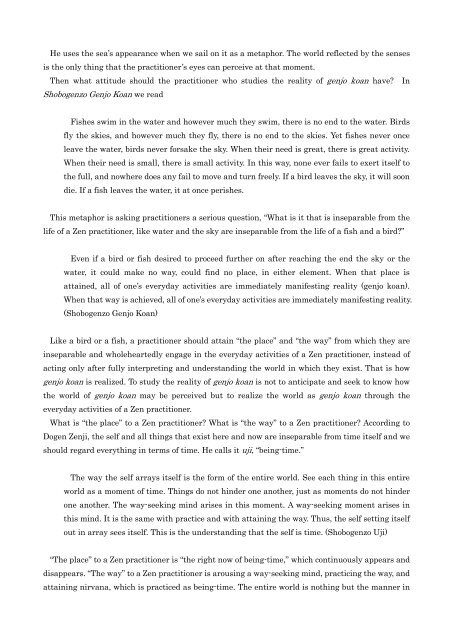
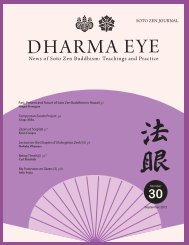
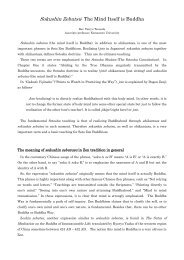

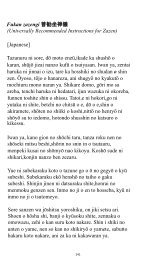

![(Daihishin darani 大æ²å¿éç¾
å°¼ï¼ [Chinese] - sotozen-net](https://img.yumpu.com/38648887/1/156x260/daihishin-darani-aaeaec-3-4-a-1-4-i-1-4-chinese-sotozen-net.jpg?quality=85)


